Business Strategy Report: IKEA's Macro and Micro Analysis
VerifiedAdded on 2023/01/10
|16
|3812
|60
Report
AI Summary
This report provides a comprehensive analysis of IKEA's business strategy, covering both the macro and micro environments. The macro-environment analysis utilizes the PESTEL framework to assess political, economic, social, technological, environmental, and legal factors impacting IKEA's operations and profitability. The internal environment is examined through the Resource-Based View (RBV) framework, including VRIO analysis to evaluate valuable, rare, inimitable, and organized resources, and a SWOT analysis to identify IKEA's strengths, weaknesses, opportunities, and threats. Furthermore, the report applies Porter's Five Forces model to assess the competitive landscape, including industry competition, potential for new entrants, supplier power, customer power, and the threat of substitute products. The analysis provides insights into IKEA's strategic position and its ability to gain a competitive edge in the market.
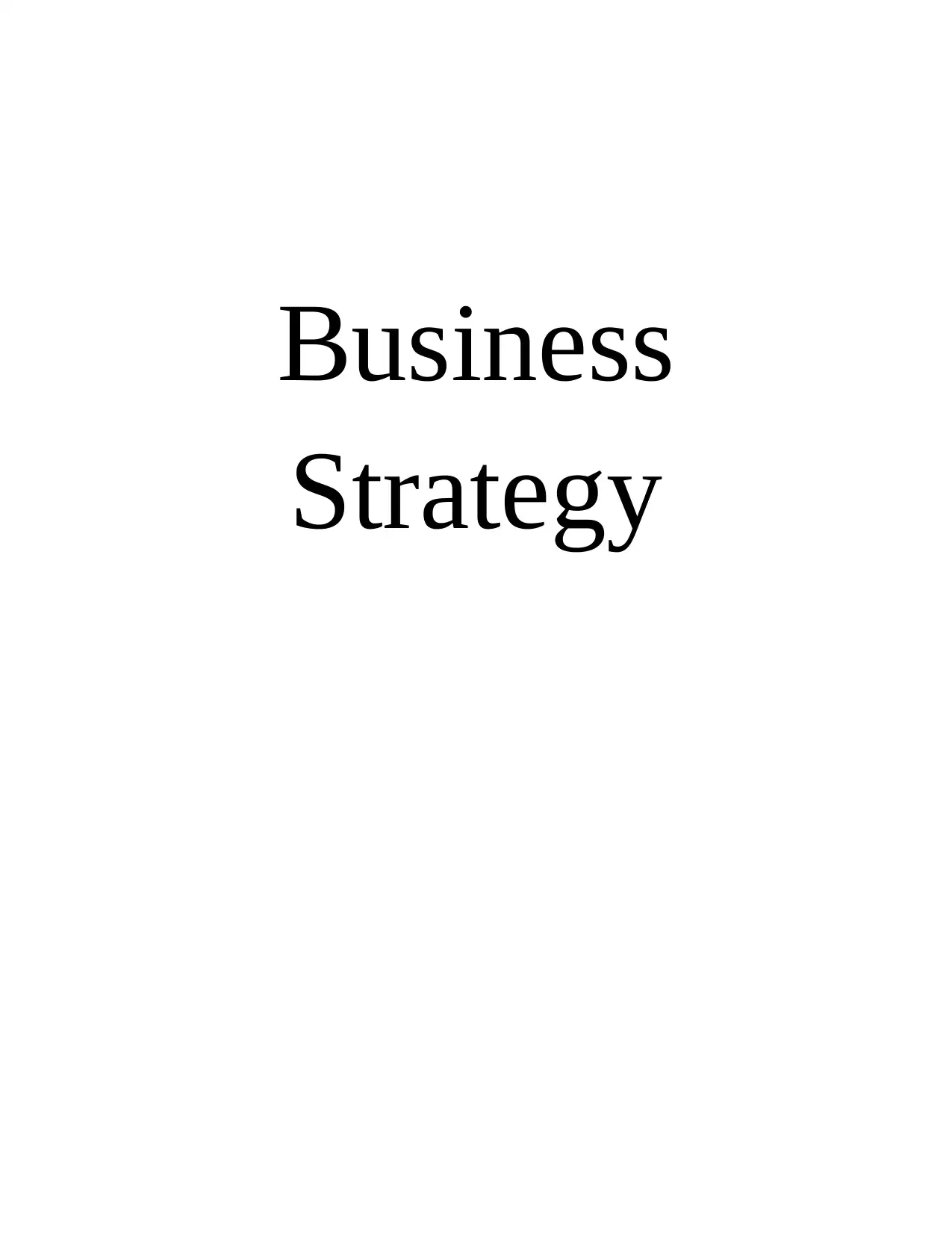
Business
Strategy
Strategy
Paraphrase This Document
Need a fresh take? Get an instant paraphrase of this document with our AI Paraphraser
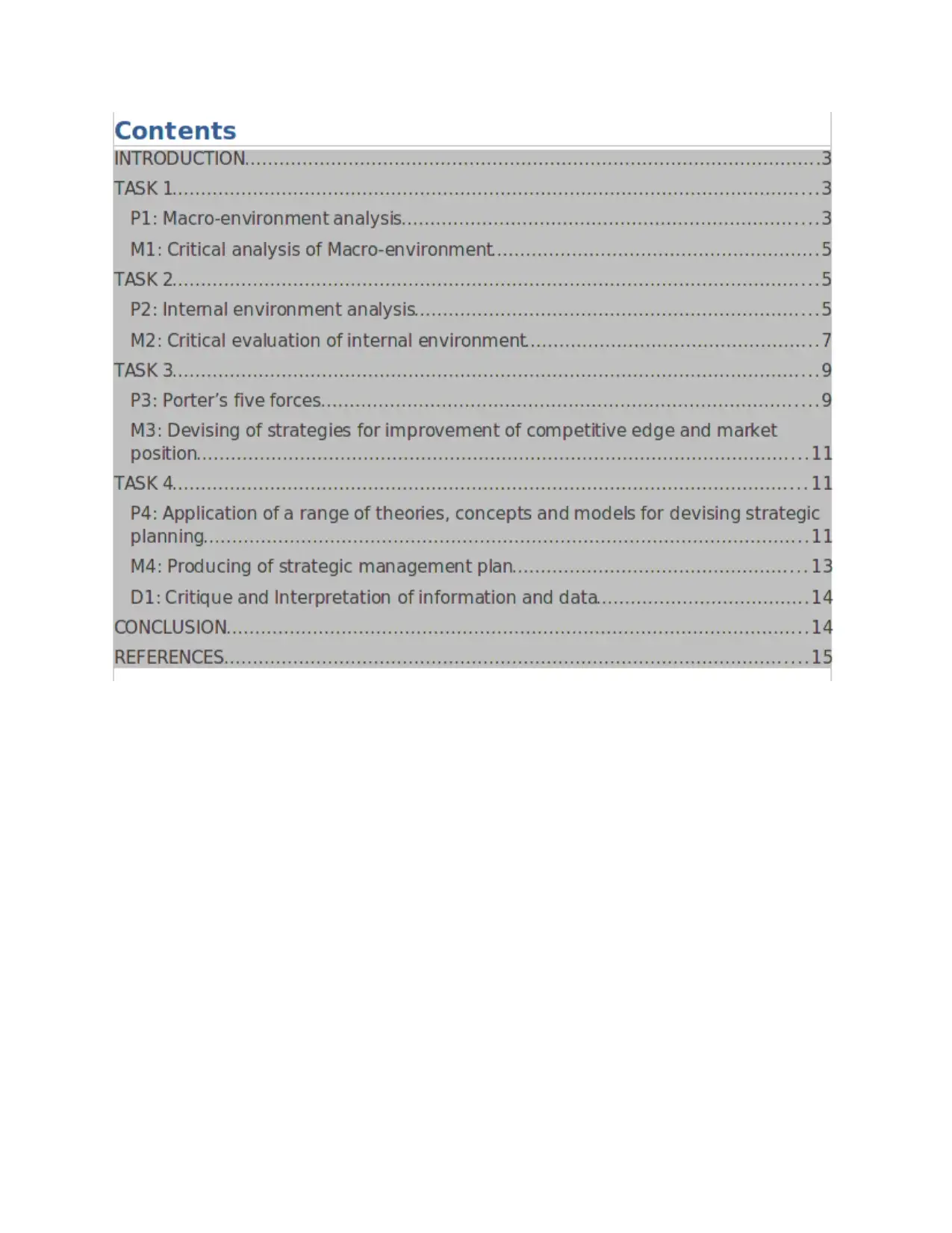
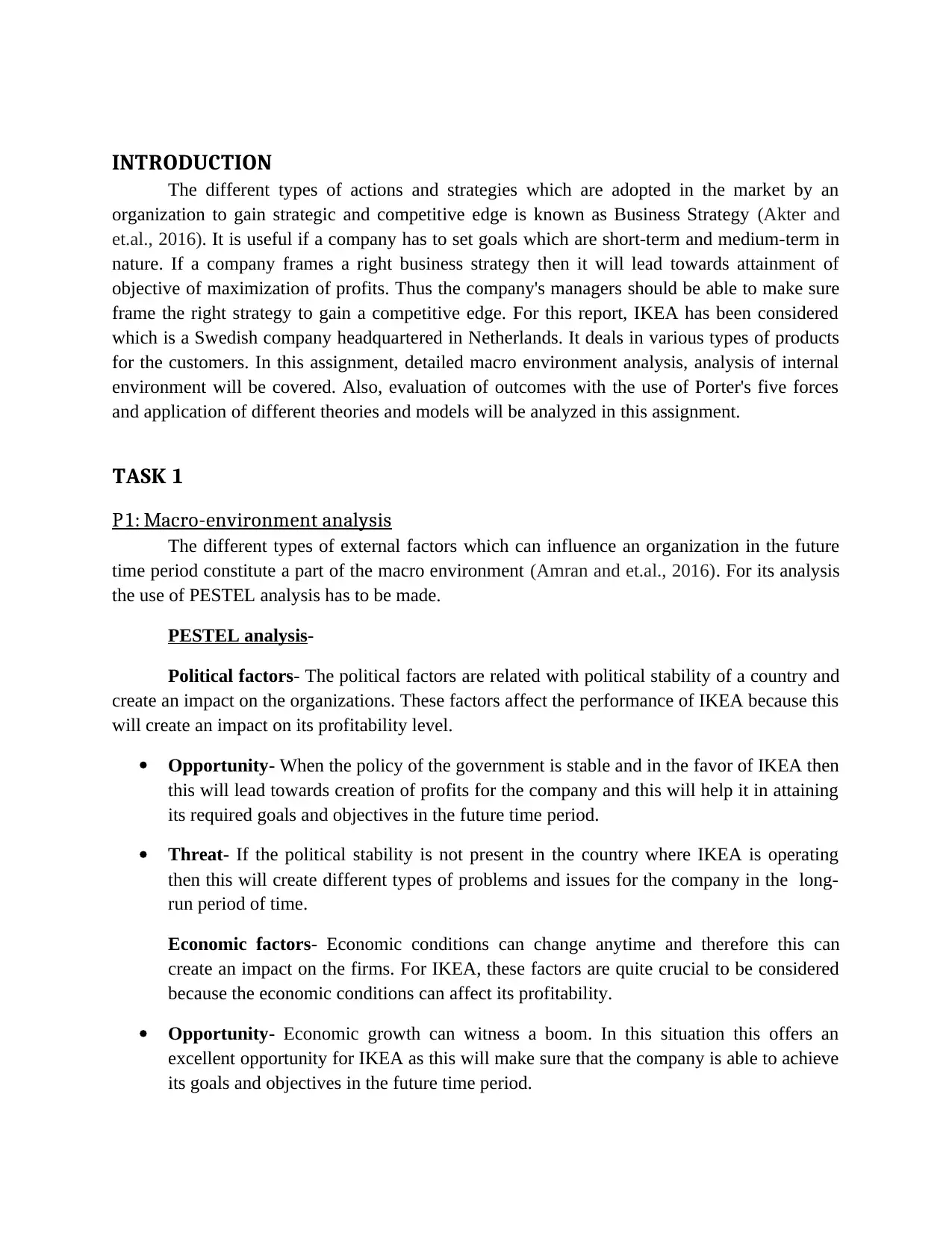
INTRODUCTION
The different types of actions and strategies which are adopted in the market by an
organization to gain strategic and competitive edge is known as Business Strategy (Akter and
et.al., 2016). It is useful if a company has to set goals which are short-term and medium-term in
nature. If a company frames a right business strategy then it will lead towards attainment of
objective of maximization of profits. Thus the company's managers should be able to make sure
frame the right strategy to gain a competitive edge. For this report, IKEA has been considered
which is a Swedish company headquartered in Netherlands. It deals in various types of products
for the customers. In this assignment, detailed macro environment analysis, analysis of internal
environment will be covered. Also, evaluation of outcomes with the use of Porter's five forces
and application of different theories and models will be analyzed in this assignment.
TASK 1
P1: Macro-environment analysis
The different types of external factors which can influence an organization in the future
time period constitute a part of the macro environment (Amran and et.al., 2016). For its analysis
the use of PESTEL analysis has to be made.
PESTEL analysis-
Political factors- The political factors are related with political stability of a country and
create an impact on the organizations. These factors affect the performance of IKEA because this
will create an impact on its profitability level.
Opportunity- When the policy of the government is stable and in the favor of IKEA then
this will lead towards creation of profits for the company and this will help it in attaining
its required goals and objectives in the future time period.
Threat- If the political stability is not present in the country where IKEA is operating
then this will create different types of problems and issues for the company in the long-
run period of time.
Economic factors- Economic conditions can change anytime and therefore this can
create an impact on the firms. For IKEA, these factors are quite crucial to be considered
because the economic conditions can affect its profitability.
Opportunity- Economic growth can witness a boom. In this situation this offers an
excellent opportunity for IKEA as this will make sure that the company is able to achieve
its goals and objectives in the future time period.
The different types of actions and strategies which are adopted in the market by an
organization to gain strategic and competitive edge is known as Business Strategy (Akter and
et.al., 2016). It is useful if a company has to set goals which are short-term and medium-term in
nature. If a company frames a right business strategy then it will lead towards attainment of
objective of maximization of profits. Thus the company's managers should be able to make sure
frame the right strategy to gain a competitive edge. For this report, IKEA has been considered
which is a Swedish company headquartered in Netherlands. It deals in various types of products
for the customers. In this assignment, detailed macro environment analysis, analysis of internal
environment will be covered. Also, evaluation of outcomes with the use of Porter's five forces
and application of different theories and models will be analyzed in this assignment.
TASK 1
P1: Macro-environment analysis
The different types of external factors which can influence an organization in the future
time period constitute a part of the macro environment (Amran and et.al., 2016). For its analysis
the use of PESTEL analysis has to be made.
PESTEL analysis-
Political factors- The political factors are related with political stability of a country and
create an impact on the organizations. These factors affect the performance of IKEA because this
will create an impact on its profitability level.
Opportunity- When the policy of the government is stable and in the favor of IKEA then
this will lead towards creation of profits for the company and this will help it in attaining
its required goals and objectives in the future time period.
Threat- If the political stability is not present in the country where IKEA is operating
then this will create different types of problems and issues for the company in the long-
run period of time.
Economic factors- Economic conditions can change anytime and therefore this can
create an impact on the firms. For IKEA, these factors are quite crucial to be considered
because the economic conditions can affect its profitability.
Opportunity- Economic growth can witness a boom. In this situation this offers an
excellent opportunity for IKEA as this will make sure that the company is able to achieve
its goals and objectives in the future time period.
⊘ This is a preview!⊘
Do you want full access?
Subscribe today to unlock all pages.

Trusted by 1+ million students worldwide
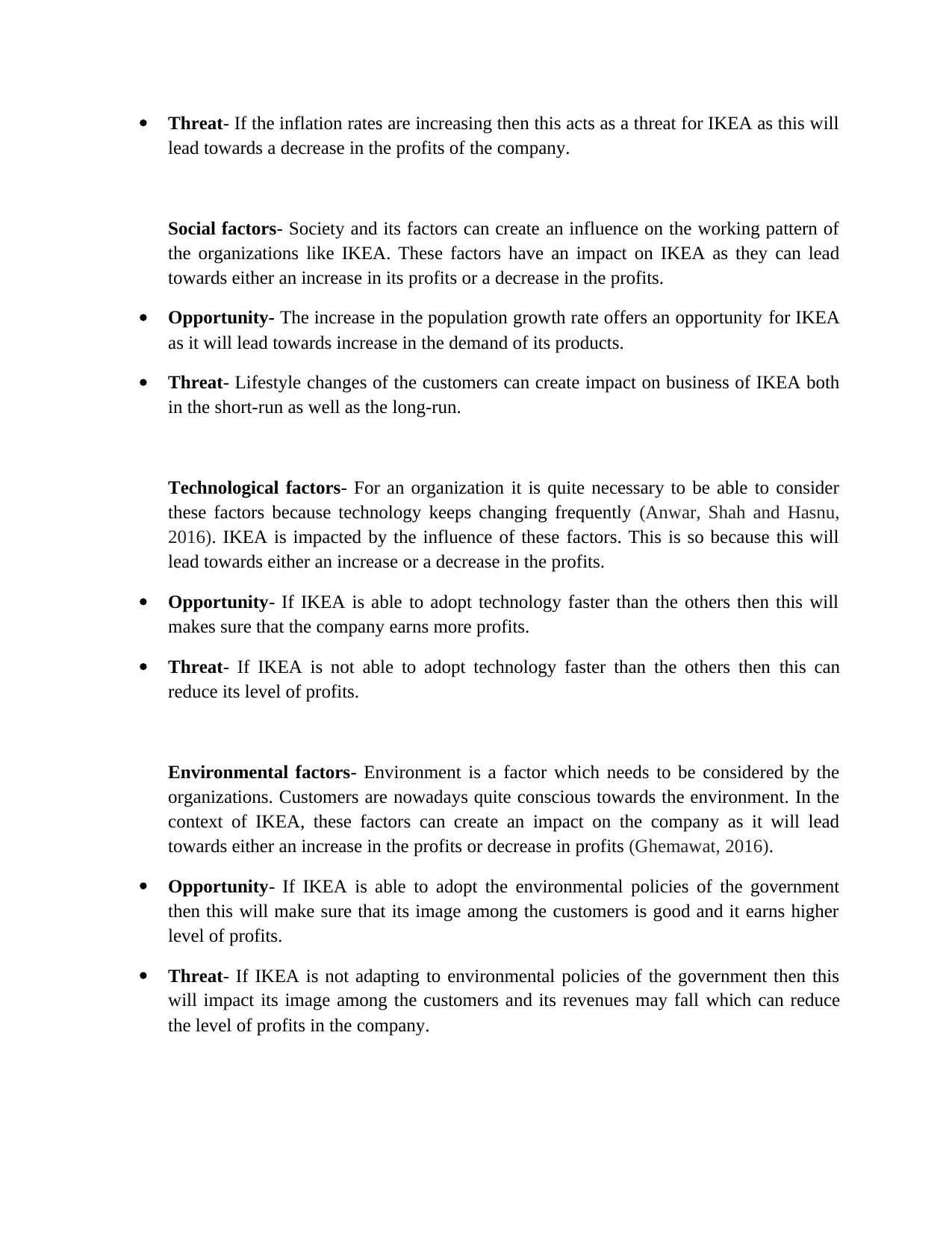
Threat- If the inflation rates are increasing then this acts as a threat for IKEA as this will
lead towards a decrease in the profits of the company.
Social factors- Society and its factors can create an influence on the working pattern of
the organizations like IKEA. These factors have an impact on IKEA as they can lead
towards either an increase in its profits or a decrease in the profits.
Opportunity- The increase in the population growth rate offers an opportunity for IKEA
as it will lead towards increase in the demand of its products.
Threat- Lifestyle changes of the customers can create impact on business of IKEA both
in the short-run as well as the long-run.
Technological factors- For an organization it is quite necessary to be able to consider
these factors because technology keeps changing frequently (Anwar, Shah and Hasnu,
2016). IKEA is impacted by the influence of these factors. This is so because this will
lead towards either an increase or a decrease in the profits.
Opportunity- If IKEA is able to adopt technology faster than the others then this will
makes sure that the company earns more profits.
Threat- If IKEA is not able to adopt technology faster than the others then this can
reduce its level of profits.
Environmental factors- Environment is a factor which needs to be considered by the
organizations. Customers are nowadays quite conscious towards the environment. In the
context of IKEA, these factors can create an impact on the company as it will lead
towards either an increase in the profits or decrease in profits (Ghemawat, 2016).
Opportunity- If IKEA is able to adopt the environmental policies of the government
then this will make sure that its image among the customers is good and it earns higher
level of profits.
Threat- If IKEA is not adapting to environmental policies of the government then this
will impact its image among the customers and its revenues may fall which can reduce
the level of profits in the company.
lead towards a decrease in the profits of the company.
Social factors- Society and its factors can create an influence on the working pattern of
the organizations like IKEA. These factors have an impact on IKEA as they can lead
towards either an increase in its profits or a decrease in the profits.
Opportunity- The increase in the population growth rate offers an opportunity for IKEA
as it will lead towards increase in the demand of its products.
Threat- Lifestyle changes of the customers can create impact on business of IKEA both
in the short-run as well as the long-run.
Technological factors- For an organization it is quite necessary to be able to consider
these factors because technology keeps changing frequently (Anwar, Shah and Hasnu,
2016). IKEA is impacted by the influence of these factors. This is so because this will
lead towards either an increase or a decrease in the profits.
Opportunity- If IKEA is able to adopt technology faster than the others then this will
makes sure that the company earns more profits.
Threat- If IKEA is not able to adopt technology faster than the others then this can
reduce its level of profits.
Environmental factors- Environment is a factor which needs to be considered by the
organizations. Customers are nowadays quite conscious towards the environment. In the
context of IKEA, these factors can create an impact on the company as it will lead
towards either an increase in the profits or decrease in profits (Ghemawat, 2016).
Opportunity- If IKEA is able to adopt the environmental policies of the government
then this will make sure that its image among the customers is good and it earns higher
level of profits.
Threat- If IKEA is not adapting to environmental policies of the government then this
will impact its image among the customers and its revenues may fall which can reduce
the level of profits in the company.
Paraphrase This Document
Need a fresh take? Get an instant paraphrase of this document with our AI Paraphraser
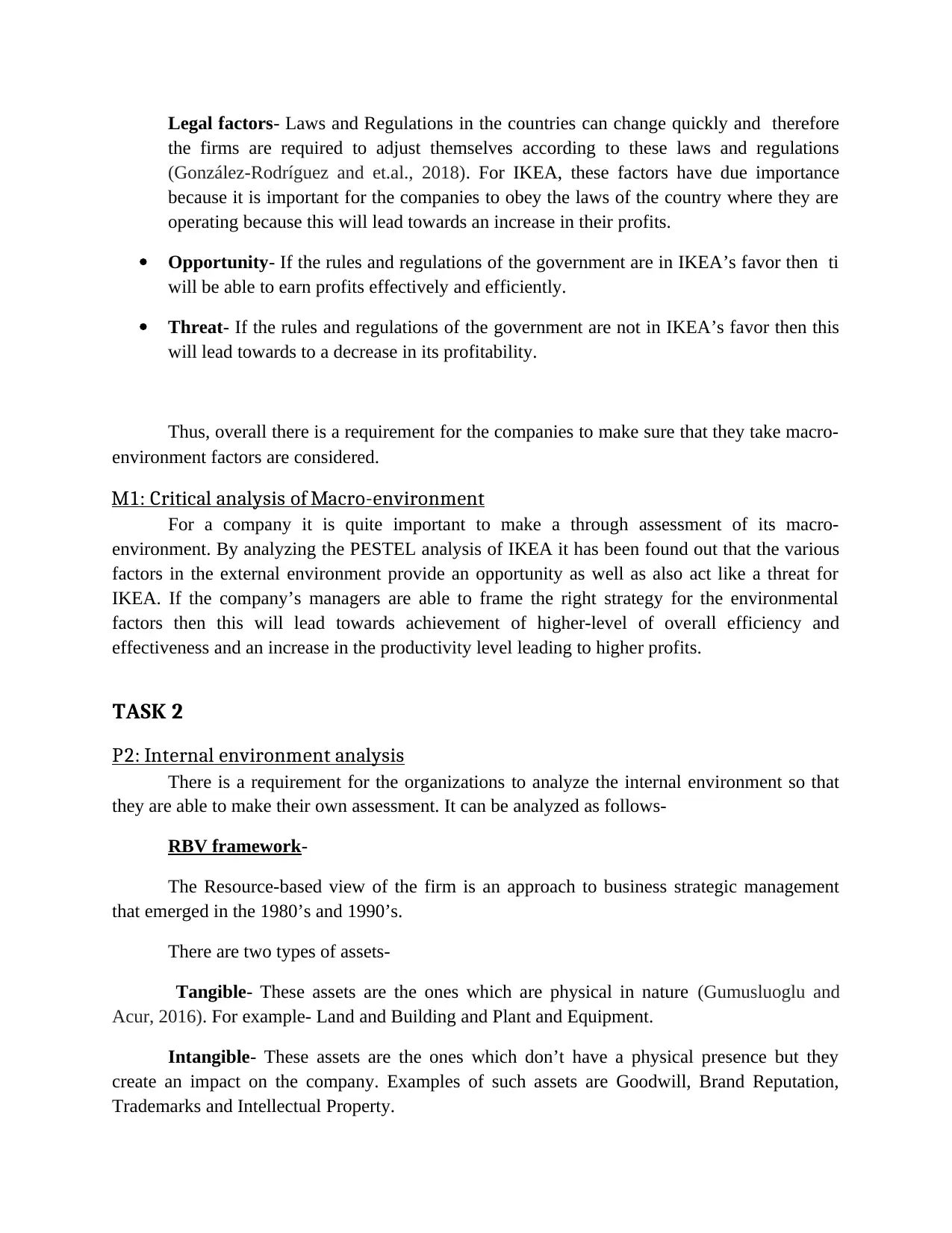
Legal factors- Laws and Regulations in the countries can change quickly and therefore
the firms are required to adjust themselves according to these laws and regulations
(González-Rodríguez and et.al., 2018). For IKEA, these factors have due importance
because it is important for the companies to obey the laws of the country where they are
operating because this will lead towards an increase in their profits.
Opportunity- If the rules and regulations of the government are in IKEA’s favor then ti
will be able to earn profits effectively and efficiently.
Threat- If the rules and regulations of the government are not in IKEA’s favor then this
will lead towards to a decrease in its profitability.
Thus, overall there is a requirement for the companies to make sure that they take macro-
environment factors are considered.
M1: Critical analysis of Macro-environment
For a company it is quite important to make a through assessment of its macro-
environment. By analyzing the PESTEL analysis of IKEA it has been found out that the various
factors in the external environment provide an opportunity as well as also act like a threat for
IKEA. If the company’s managers are able to frame the right strategy for the environmental
factors then this will lead towards achievement of higher-level of overall efficiency and
effectiveness and an increase in the productivity level leading to higher profits.
TASK 2
P2: Internal environment analysis
There is a requirement for the organizations to analyze the internal environment so that
they are able to make their own assessment. It can be analyzed as follows-
RBV framework-
The Resource-based view of the firm is an approach to business strategic management
that emerged in the 1980’s and 1990’s.
There are two types of assets-
Tangible- These assets are the ones which are physical in nature (Gumusluoglu and
Acur, 2016). For example- Land and Building and Plant and Equipment.
Intangible- These assets are the ones which don’t have a physical presence but they
create an impact on the company. Examples of such assets are Goodwill, Brand Reputation,
Trademarks and Intellectual Property.
the firms are required to adjust themselves according to these laws and regulations
(González-Rodríguez and et.al., 2018). For IKEA, these factors have due importance
because it is important for the companies to obey the laws of the country where they are
operating because this will lead towards an increase in their profits.
Opportunity- If the rules and regulations of the government are in IKEA’s favor then ti
will be able to earn profits effectively and efficiently.
Threat- If the rules and regulations of the government are not in IKEA’s favor then this
will lead towards to a decrease in its profitability.
Thus, overall there is a requirement for the companies to make sure that they take macro-
environment factors are considered.
M1: Critical analysis of Macro-environment
For a company it is quite important to make a through assessment of its macro-
environment. By analyzing the PESTEL analysis of IKEA it has been found out that the various
factors in the external environment provide an opportunity as well as also act like a threat for
IKEA. If the company’s managers are able to frame the right strategy for the environmental
factors then this will lead towards achievement of higher-level of overall efficiency and
effectiveness and an increase in the productivity level leading to higher profits.
TASK 2
P2: Internal environment analysis
There is a requirement for the organizations to analyze the internal environment so that
they are able to make their own assessment. It can be analyzed as follows-
RBV framework-
The Resource-based view of the firm is an approach to business strategic management
that emerged in the 1980’s and 1990’s.
There are two types of assets-
Tangible- These assets are the ones which are physical in nature (Gumusluoglu and
Acur, 2016). For example- Land and Building and Plant and Equipment.
Intangible- These assets are the ones which don’t have a physical presence but they
create an impact on the company. Examples of such assets are Goodwill, Brand Reputation,
Trademarks and Intellectual Property.
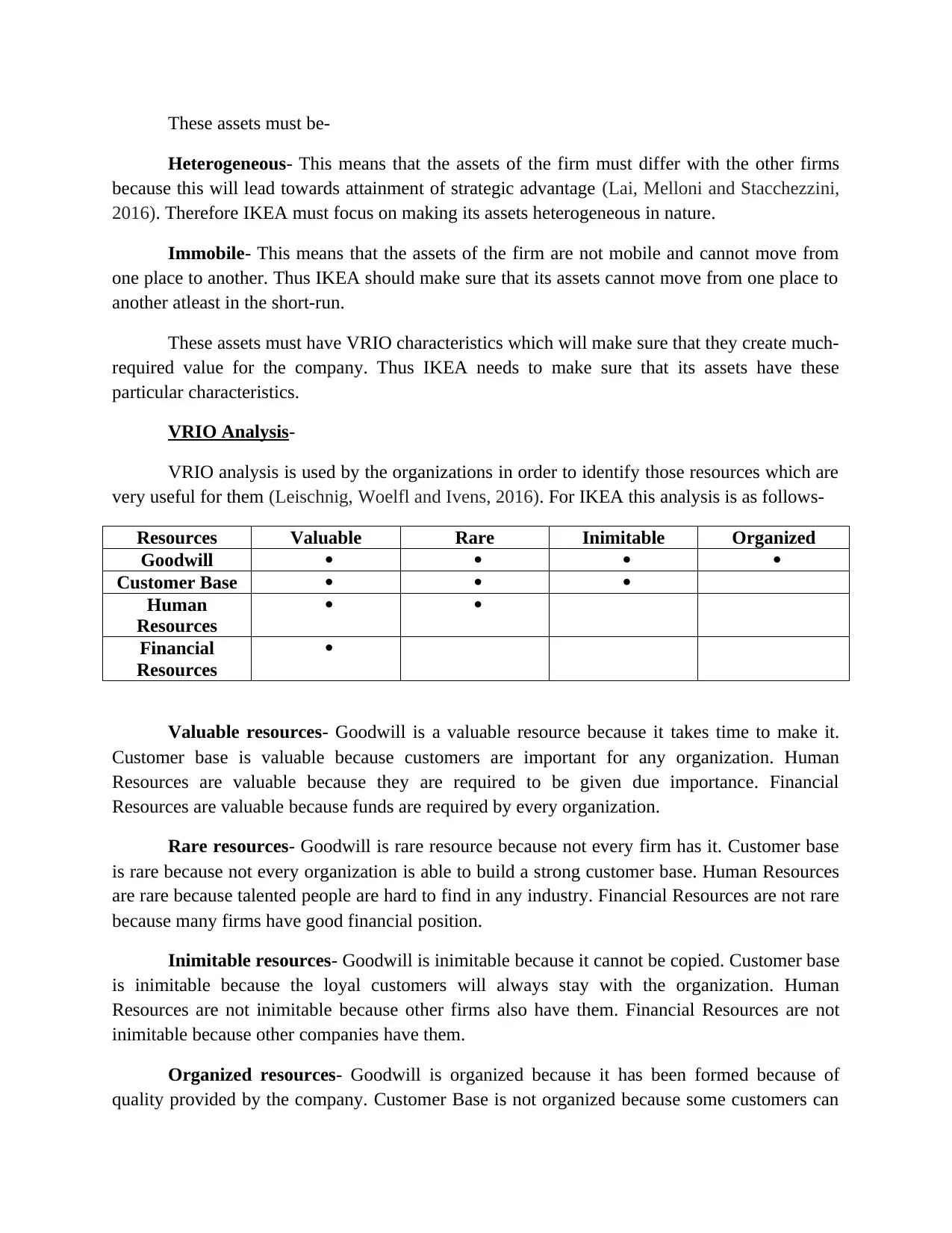
These assets must be-
Heterogeneous- This means that the assets of the firm must differ with the other firms
because this will lead towards attainment of strategic advantage (Lai, Melloni and Stacchezzini,
2016). Therefore IKEA must focus on making its assets heterogeneous in nature.
Immobile- This means that the assets of the firm are not mobile and cannot move from
one place to another. Thus IKEA should make sure that its assets cannot move from one place to
another atleast in the short-run.
These assets must have VRIO characteristics which will make sure that they create much-
required value for the company. Thus IKEA needs to make sure that its assets have these
particular characteristics.
VRIO Analysis-
VRIO analysis is used by the organizations in order to identify those resources which are
very useful for them (Leischnig, Woelfl and Ivens, 2016). For IKEA this analysis is as follows-
Resources Valuable Rare Inimitable Organized
Goodwill
Customer Base
Human
Resources
Financial
Resources
Valuable resources- Goodwill is a valuable resource because it takes time to make it.
Customer base is valuable because customers are important for any organization. Human
Resources are valuable because they are required to be given due importance. Financial
Resources are valuable because funds are required by every organization.
Rare resources- Goodwill is rare resource because not every firm has it. Customer base
is rare because not every organization is able to build a strong customer base. Human Resources
are rare because talented people are hard to find in any industry. Financial Resources are not rare
because many firms have good financial position.
Inimitable resources- Goodwill is inimitable because it cannot be copied. Customer base
is inimitable because the loyal customers will always stay with the organization. Human
Resources are not inimitable because other firms also have them. Financial Resources are not
inimitable because other companies have them.
Organized resources- Goodwill is organized because it has been formed because of
quality provided by the company. Customer Base is not organized because some customers can
Heterogeneous- This means that the assets of the firm must differ with the other firms
because this will lead towards attainment of strategic advantage (Lai, Melloni and Stacchezzini,
2016). Therefore IKEA must focus on making its assets heterogeneous in nature.
Immobile- This means that the assets of the firm are not mobile and cannot move from
one place to another. Thus IKEA should make sure that its assets cannot move from one place to
another atleast in the short-run.
These assets must have VRIO characteristics which will make sure that they create much-
required value for the company. Thus IKEA needs to make sure that its assets have these
particular characteristics.
VRIO Analysis-
VRIO analysis is used by the organizations in order to identify those resources which are
very useful for them (Leischnig, Woelfl and Ivens, 2016). For IKEA this analysis is as follows-
Resources Valuable Rare Inimitable Organized
Goodwill
Customer Base
Human
Resources
Financial
Resources
Valuable resources- Goodwill is a valuable resource because it takes time to make it.
Customer base is valuable because customers are important for any organization. Human
Resources are valuable because they are required to be given due importance. Financial
Resources are valuable because funds are required by every organization.
Rare resources- Goodwill is rare resource because not every firm has it. Customer base
is rare because not every organization is able to build a strong customer base. Human Resources
are rare because talented people are hard to find in any industry. Financial Resources are not rare
because many firms have good financial position.
Inimitable resources- Goodwill is inimitable because it cannot be copied. Customer base
is inimitable because the loyal customers will always stay with the organization. Human
Resources are not inimitable because other firms also have them. Financial Resources are not
inimitable because other companies have them.
Organized resources- Goodwill is organized because it has been formed because of
quality provided by the company. Customer Base is not organized because some customers can
⊘ This is a preview!⊘
Do you want full access?
Subscribe today to unlock all pages.

Trusted by 1+ million students worldwide
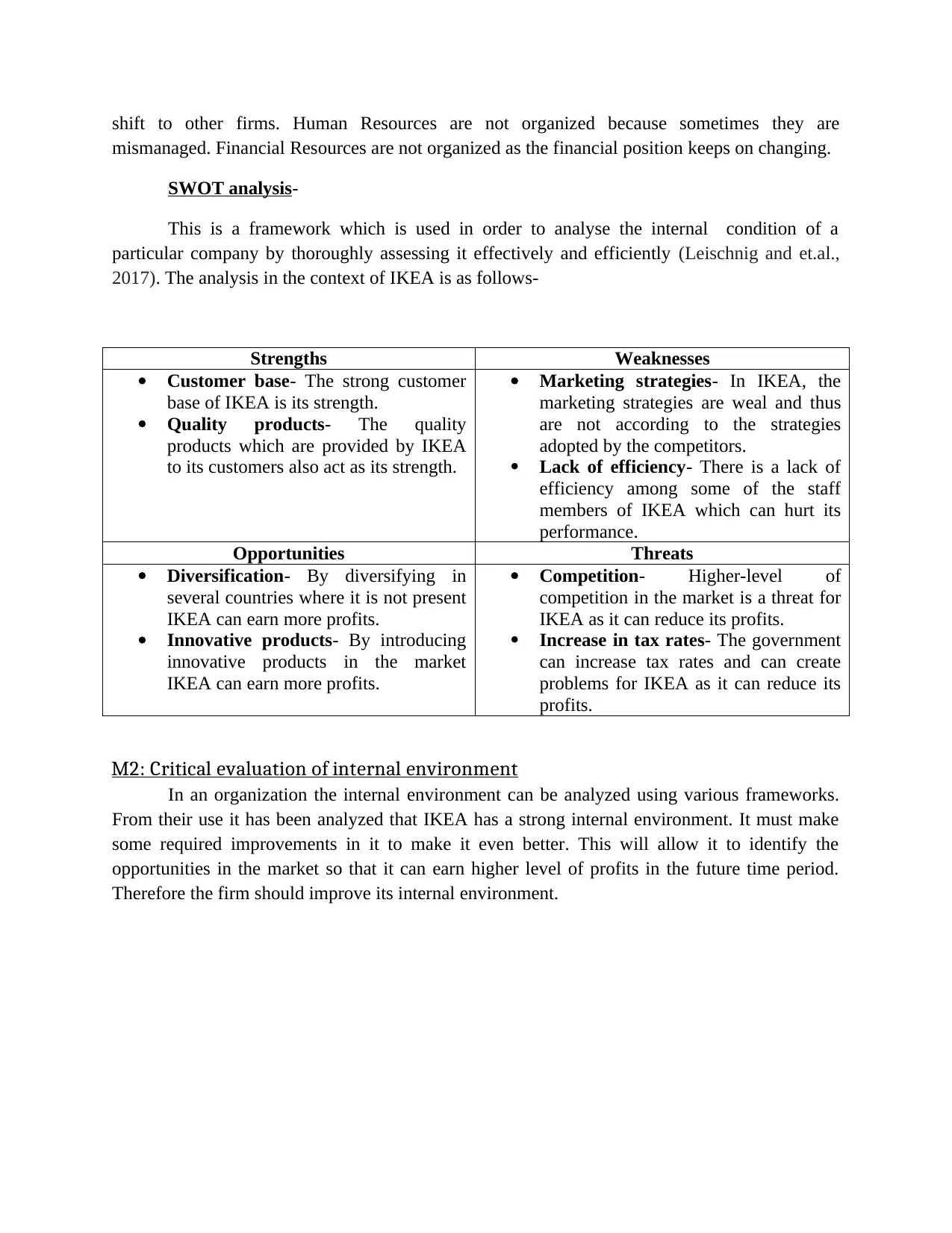
shift to other firms. Human Resources are not organized because sometimes they are
mismanaged. Financial Resources are not organized as the financial position keeps on changing.
SWOT analysis-
This is a framework which is used in order to analyse the internal condition of a
particular company by thoroughly assessing it effectively and efficiently (Leischnig and et.al.,
2017). The analysis in the context of IKEA is as follows-
Strengths Weaknesses
Customer base- The strong customer
base of IKEA is its strength.
Quality products- The quality
products which are provided by IKEA
to its customers also act as its strength.
Marketing strategies- In IKEA, the
marketing strategies are weal and thus
are not according to the strategies
adopted by the competitors.
Lack of efficiency- There is a lack of
efficiency among some of the staff
members of IKEA which can hurt its
performance.
Opportunities Threats
Diversification- By diversifying in
several countries where it is not present
IKEA can earn more profits.
Innovative products- By introducing
innovative products in the market
IKEA can earn more profits.
Competition- Higher-level of
competition in the market is a threat for
IKEA as it can reduce its profits.
Increase in tax rates- The government
can increase tax rates and can create
problems for IKEA as it can reduce its
profits.
M2: Critical evaluation of internal environment
In an organization the internal environment can be analyzed using various frameworks.
From their use it has been analyzed that IKEA has a strong internal environment. It must make
some required improvements in it to make it even better. This will allow it to identify the
opportunities in the market so that it can earn higher level of profits in the future time period.
Therefore the firm should improve its internal environment.
mismanaged. Financial Resources are not organized as the financial position keeps on changing.
SWOT analysis-
This is a framework which is used in order to analyse the internal condition of a
particular company by thoroughly assessing it effectively and efficiently (Leischnig and et.al.,
2017). The analysis in the context of IKEA is as follows-
Strengths Weaknesses
Customer base- The strong customer
base of IKEA is its strength.
Quality products- The quality
products which are provided by IKEA
to its customers also act as its strength.
Marketing strategies- In IKEA, the
marketing strategies are weal and thus
are not according to the strategies
adopted by the competitors.
Lack of efficiency- There is a lack of
efficiency among some of the staff
members of IKEA which can hurt its
performance.
Opportunities Threats
Diversification- By diversifying in
several countries where it is not present
IKEA can earn more profits.
Innovative products- By introducing
innovative products in the market
IKEA can earn more profits.
Competition- Higher-level of
competition in the market is a threat for
IKEA as it can reduce its profits.
Increase in tax rates- The government
can increase tax rates and can create
problems for IKEA as it can reduce its
profits.
M2: Critical evaluation of internal environment
In an organization the internal environment can be analyzed using various frameworks.
From their use it has been analyzed that IKEA has a strong internal environment. It must make
some required improvements in it to make it even better. This will allow it to identify the
opportunities in the market so that it can earn higher level of profits in the future time period.
Therefore the firm should improve its internal environment.
Paraphrase This Document
Need a fresh take? Get an instant paraphrase of this document with our AI Paraphraser
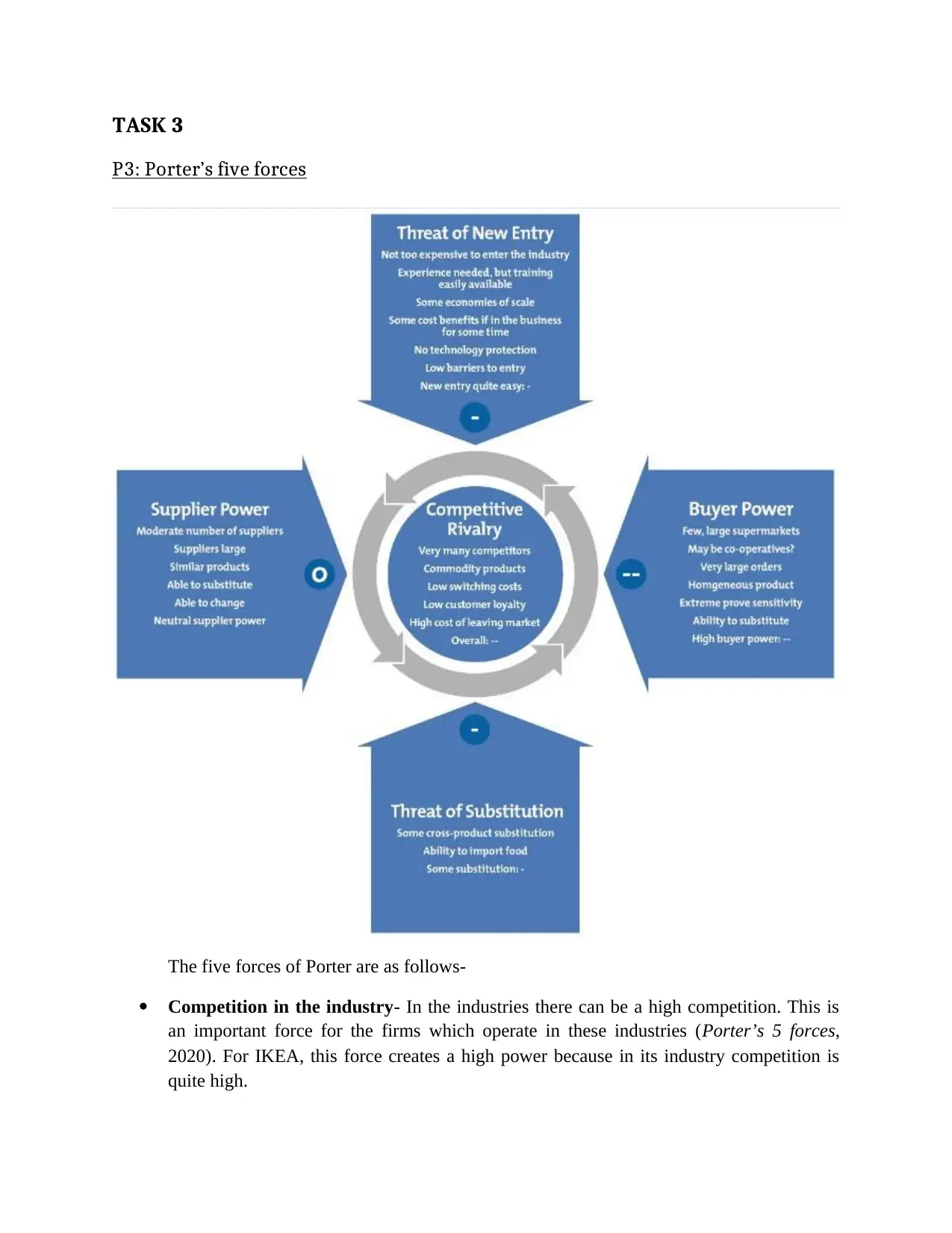
TASK 3
P3: Porter’s five forces
The five forces of Porter are as follows-
Competition in the industry- In the industries there can be a high competition. This is
an important force for the firms which operate in these industries (Porter’s 5 forces,
2020). For IKEA, this force creates a high power because in its industry competition is
quite high.
P3: Porter’s five forces
The five forces of Porter are as follows-
Competition in the industry- In the industries there can be a high competition. This is
an important force for the firms which operate in these industries (Porter’s 5 forces,
2020). For IKEA, this force creates a high power because in its industry competition is
quite high.
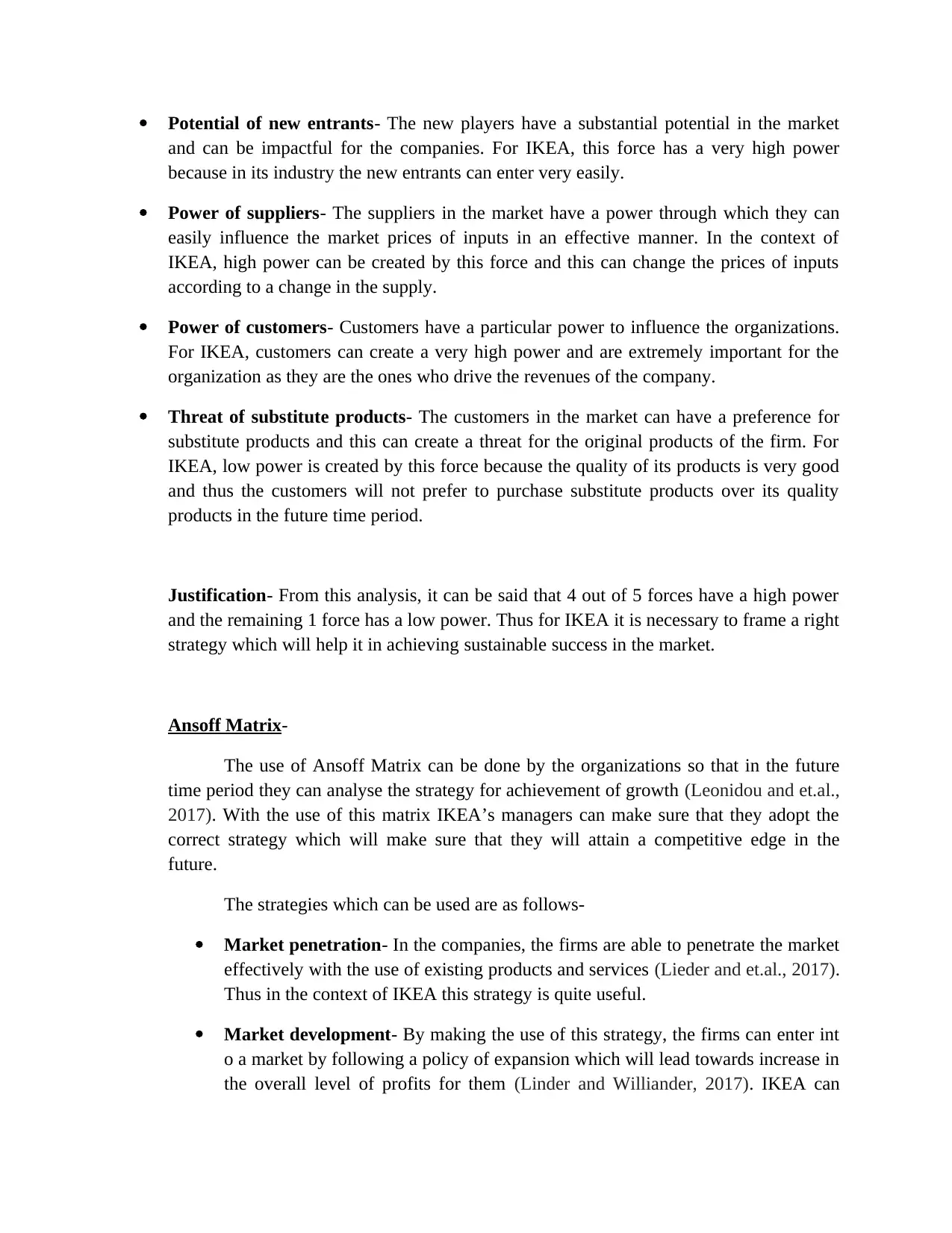
Potential of new entrants- The new players have a substantial potential in the market
and can be impactful for the companies. For IKEA, this force has a very high power
because in its industry the new entrants can enter very easily.
Power of suppliers- The suppliers in the market have a power through which they can
easily influence the market prices of inputs in an effective manner. In the context of
IKEA, high power can be created by this force and this can change the prices of inputs
according to a change in the supply.
Power of customers- Customers have a particular power to influence the organizations.
For IKEA, customers can create a very high power and are extremely important for the
organization as they are the ones who drive the revenues of the company.
Threat of substitute products- The customers in the market can have a preference for
substitute products and this can create a threat for the original products of the firm. For
IKEA, low power is created by this force because the quality of its products is very good
and thus the customers will not prefer to purchase substitute products over its quality
products in the future time period.
Justification- From this analysis, it can be said that 4 out of 5 forces have a high power
and the remaining 1 force has a low power. Thus for IKEA it is necessary to frame a right
strategy which will help it in achieving sustainable success in the market.
Ansoff Matrix-
The use of Ansoff Matrix can be done by the organizations so that in the future
time period they can analyse the strategy for achievement of growth (Leonidou and et.al.,
2017). With the use of this matrix IKEA’s managers can make sure that they adopt the
correct strategy which will make sure that they will attain a competitive edge in the
future.
The strategies which can be used are as follows-
Market penetration- In the companies, the firms are able to penetrate the market
effectively with the use of existing products and services (Lieder and et.al., 2017).
Thus in the context of IKEA this strategy is quite useful.
Market development- By making the use of this strategy, the firms can enter int
o a market by following a policy of expansion which will lead towards increase in
the overall level of profits for them (Linder and Williander, 2017). IKEA can
and can be impactful for the companies. For IKEA, this force has a very high power
because in its industry the new entrants can enter very easily.
Power of suppliers- The suppliers in the market have a power through which they can
easily influence the market prices of inputs in an effective manner. In the context of
IKEA, high power can be created by this force and this can change the prices of inputs
according to a change in the supply.
Power of customers- Customers have a particular power to influence the organizations.
For IKEA, customers can create a very high power and are extremely important for the
organization as they are the ones who drive the revenues of the company.
Threat of substitute products- The customers in the market can have a preference for
substitute products and this can create a threat for the original products of the firm. For
IKEA, low power is created by this force because the quality of its products is very good
and thus the customers will not prefer to purchase substitute products over its quality
products in the future time period.
Justification- From this analysis, it can be said that 4 out of 5 forces have a high power
and the remaining 1 force has a low power. Thus for IKEA it is necessary to frame a right
strategy which will help it in achieving sustainable success in the market.
Ansoff Matrix-
The use of Ansoff Matrix can be done by the organizations so that in the future
time period they can analyse the strategy for achievement of growth (Leonidou and et.al.,
2017). With the use of this matrix IKEA’s managers can make sure that they adopt the
correct strategy which will make sure that they will attain a competitive edge in the
future.
The strategies which can be used are as follows-
Market penetration- In the companies, the firms are able to penetrate the market
effectively with the use of existing products and services (Lieder and et.al., 2017).
Thus in the context of IKEA this strategy is quite useful.
Market development- By making the use of this strategy, the firms can enter int
o a market by following a policy of expansion which will lead towards increase in
the overall level of profits for them (Linder and Williander, 2017). IKEA can
⊘ This is a preview!⊘
Do you want full access?
Subscribe today to unlock all pages.

Trusted by 1+ million students worldwide
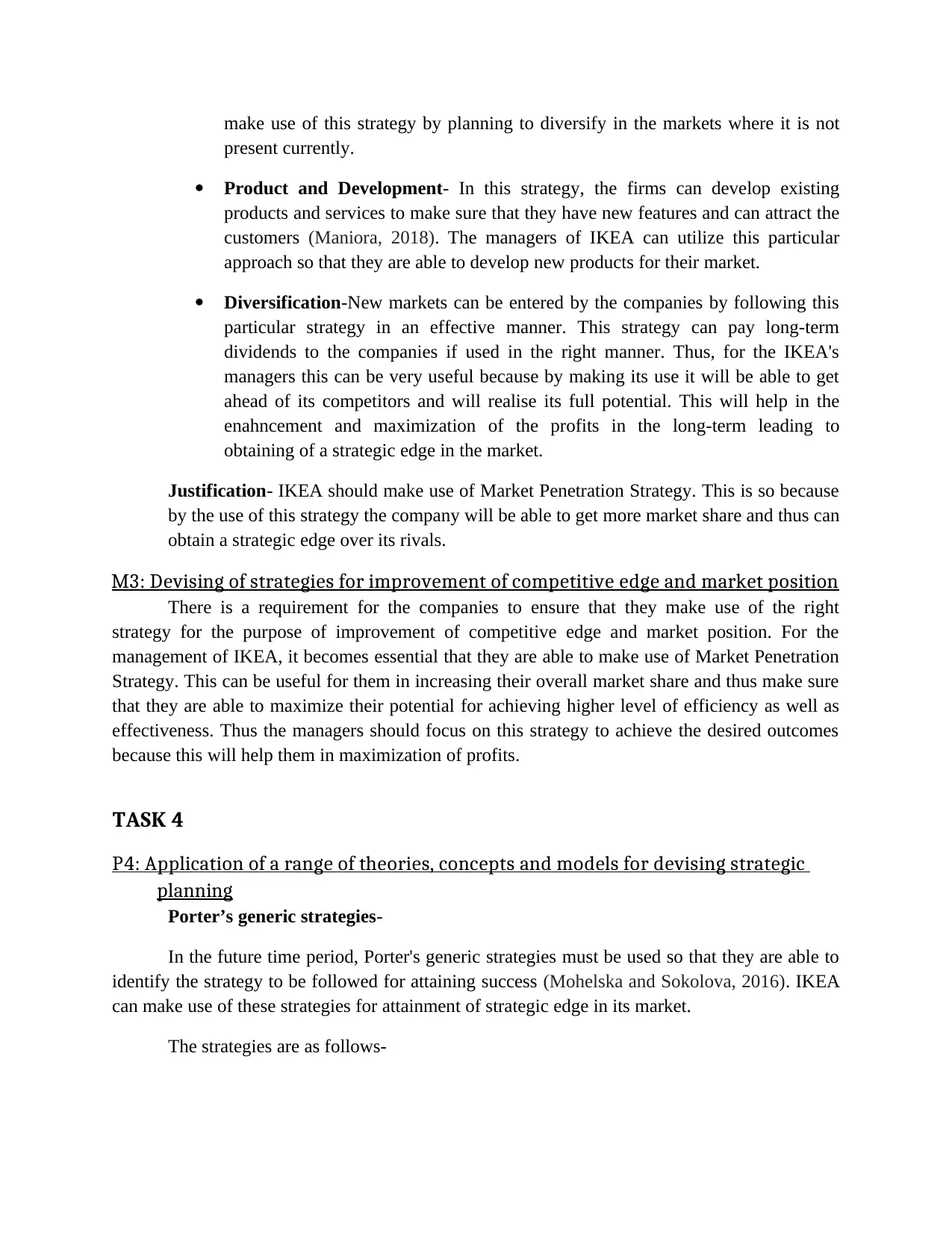
make use of this strategy by planning to diversify in the markets where it is not
present currently.
Product and Development- In this strategy, the firms can develop existing
products and services to make sure that they have new features and can attract the
customers (Maniora, 2018). The managers of IKEA can utilize this particular
approach so that they are able to develop new products for their market.
Diversification-New markets can be entered by the companies by following this
particular strategy in an effective manner. This strategy can pay long-term
dividends to the companies if used in the right manner. Thus, for the IKEA's
managers this can be very useful because by making its use it will be able to get
ahead of its competitors and will realise its full potential. This will help in the
enahncement and maximization of the profits in the long-term leading to
obtaining of a strategic edge in the market.
Justification- IKEA should make use of Market Penetration Strategy. This is so because
by the use of this strategy the company will be able to get more market share and thus can
obtain a strategic edge over its rivals.
M3: Devising of strategies for improvement of competitive edge and market position
There is a requirement for the companies to ensure that they make use of the right
strategy for the purpose of improvement of competitive edge and market position. For the
management of IKEA, it becomes essential that they are able to make use of Market Penetration
Strategy. This can be useful for them in increasing their overall market share and thus make sure
that they are able to maximize their potential for achieving higher level of efficiency as well as
effectiveness. Thus the managers should focus on this strategy to achieve the desired outcomes
because this will help them in maximization of profits.
TASK 4
P4: Application of a range of theories, concepts and models for devising strategic
planning
Porter’s generic strategies-
In the future time period, Porter's generic strategies must be used so that they are able to
identify the strategy to be followed for attaining success (Mohelska and Sokolova, 2016). IKEA
can make use of these strategies for attainment of strategic edge in its market.
The strategies are as follows-
present currently.
Product and Development- In this strategy, the firms can develop existing
products and services to make sure that they have new features and can attract the
customers (Maniora, 2018). The managers of IKEA can utilize this particular
approach so that they are able to develop new products for their market.
Diversification-New markets can be entered by the companies by following this
particular strategy in an effective manner. This strategy can pay long-term
dividends to the companies if used in the right manner. Thus, for the IKEA's
managers this can be very useful because by making its use it will be able to get
ahead of its competitors and will realise its full potential. This will help in the
enahncement and maximization of the profits in the long-term leading to
obtaining of a strategic edge in the market.
Justification- IKEA should make use of Market Penetration Strategy. This is so because
by the use of this strategy the company will be able to get more market share and thus can
obtain a strategic edge over its rivals.
M3: Devising of strategies for improvement of competitive edge and market position
There is a requirement for the companies to ensure that they make use of the right
strategy for the purpose of improvement of competitive edge and market position. For the
management of IKEA, it becomes essential that they are able to make use of Market Penetration
Strategy. This can be useful for them in increasing their overall market share and thus make sure
that they are able to maximize their potential for achieving higher level of efficiency as well as
effectiveness. Thus the managers should focus on this strategy to achieve the desired outcomes
because this will help them in maximization of profits.
TASK 4
P4: Application of a range of theories, concepts and models for devising strategic
planning
Porter’s generic strategies-
In the future time period, Porter's generic strategies must be used so that they are able to
identify the strategy to be followed for attaining success (Mohelska and Sokolova, 2016). IKEA
can make use of these strategies for attainment of strategic edge in its market.
The strategies are as follows-
Paraphrase This Document
Need a fresh take? Get an instant paraphrase of this document with our AI Paraphraser
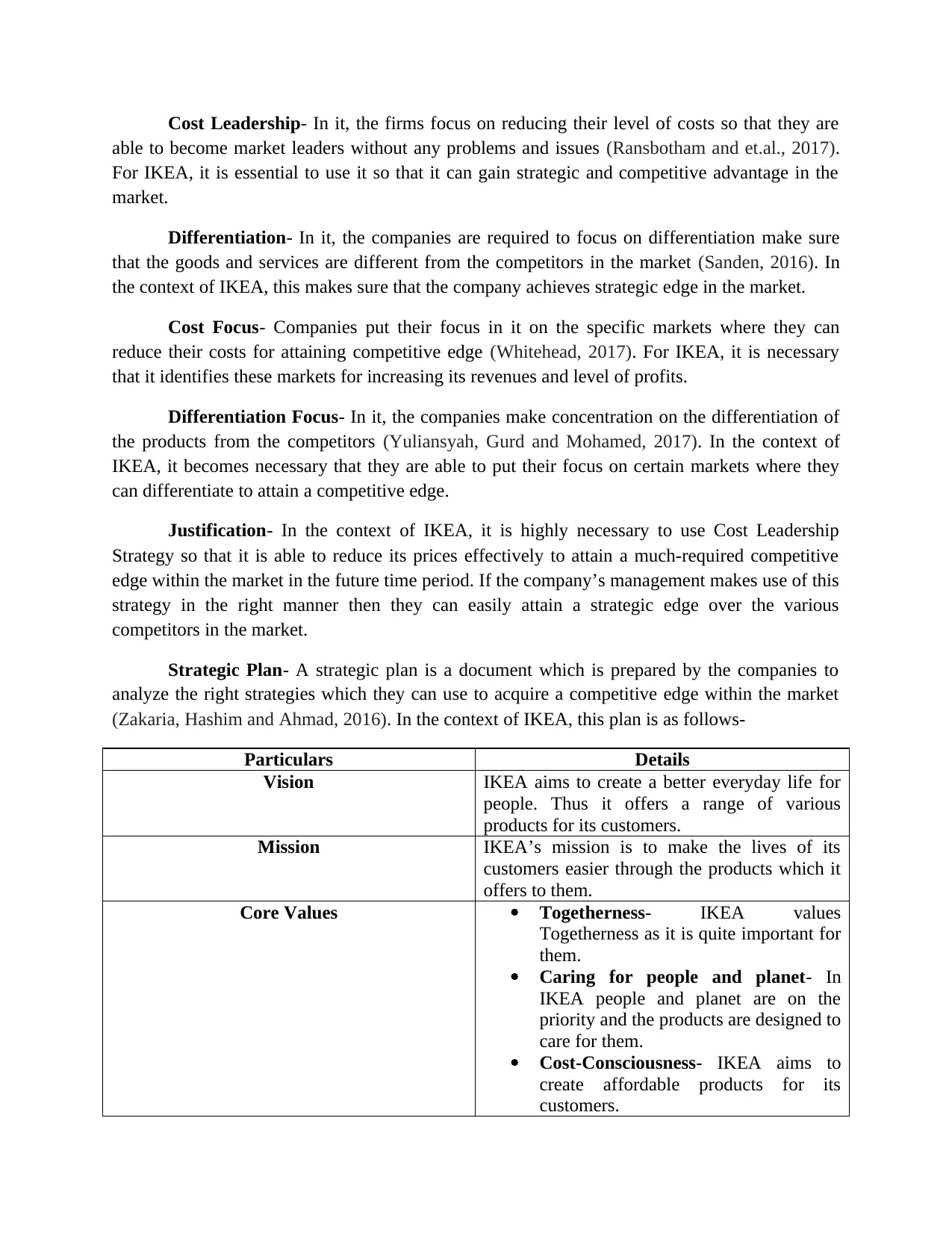
Cost Leadership- In it, the firms focus on reducing their level of costs so that they are
able to become market leaders without any problems and issues (Ransbotham and et.al., 2017).
For IKEA, it is essential to use it so that it can gain strategic and competitive advantage in the
market.
Differentiation- In it, the companies are required to focus on differentiation make sure
that the goods and services are different from the competitors in the market (Sanden, 2016). In
the context of IKEA, this makes sure that the company achieves strategic edge in the market.
Cost Focus- Companies put their focus in it on the specific markets where they can
reduce their costs for attaining competitive edge (Whitehead, 2017). For IKEA, it is necessary
that it identifies these markets for increasing its revenues and level of profits.
Differentiation Focus- In it, the companies make concentration on the differentiation of
the products from the competitors (Yuliansyah, Gurd and Mohamed, 2017). In the context of
IKEA, it becomes necessary that they are able to put their focus on certain markets where they
can differentiate to attain a competitive edge.
Justification- In the context of IKEA, it is highly necessary to use Cost Leadership
Strategy so that it is able to reduce its prices effectively to attain a much-required competitive
edge within the market in the future time period. If the company’s management makes use of this
strategy in the right manner then they can easily attain a strategic edge over the various
competitors in the market.
Strategic Plan- A strategic plan is a document which is prepared by the companies to
analyze the right strategies which they can use to acquire a competitive edge within the market
(Zakaria, Hashim and Ahmad, 2016). In the context of IKEA, this plan is as follows-
Particulars Details
Vision IKEA aims to create a better everyday life for
people. Thus it offers a range of various
products for its customers.
Mission IKEA’s mission is to make the lives of its
customers easier through the products which it
offers to them.
Core Values Togetherness- IKEA values
Togetherness as it is quite important for
them.
Caring for people and planet- In
IKEA people and planet are on the
priority and the products are designed to
care for them.
Cost-Consciousness- IKEA aims to
create affordable products for its
customers.
able to become market leaders without any problems and issues (Ransbotham and et.al., 2017).
For IKEA, it is essential to use it so that it can gain strategic and competitive advantage in the
market.
Differentiation- In it, the companies are required to focus on differentiation make sure
that the goods and services are different from the competitors in the market (Sanden, 2016). In
the context of IKEA, this makes sure that the company achieves strategic edge in the market.
Cost Focus- Companies put their focus in it on the specific markets where they can
reduce their costs for attaining competitive edge (Whitehead, 2017). For IKEA, it is necessary
that it identifies these markets for increasing its revenues and level of profits.
Differentiation Focus- In it, the companies make concentration on the differentiation of
the products from the competitors (Yuliansyah, Gurd and Mohamed, 2017). In the context of
IKEA, it becomes necessary that they are able to put their focus on certain markets where they
can differentiate to attain a competitive edge.
Justification- In the context of IKEA, it is highly necessary to use Cost Leadership
Strategy so that it is able to reduce its prices effectively to attain a much-required competitive
edge within the market in the future time period. If the company’s management makes use of this
strategy in the right manner then they can easily attain a strategic edge over the various
competitors in the market.
Strategic Plan- A strategic plan is a document which is prepared by the companies to
analyze the right strategies which they can use to acquire a competitive edge within the market
(Zakaria, Hashim and Ahmad, 2016). In the context of IKEA, this plan is as follows-
Particulars Details
Vision IKEA aims to create a better everyday life for
people. Thus it offers a range of various
products for its customers.
Mission IKEA’s mission is to make the lives of its
customers easier through the products which it
offers to them.
Core Values Togetherness- IKEA values
Togetherness as it is quite important for
them.
Caring for people and planet- In
IKEA people and planet are on the
priority and the products are designed to
care for them.
Cost-Consciousness- IKEA aims to
create affordable products for its
customers.
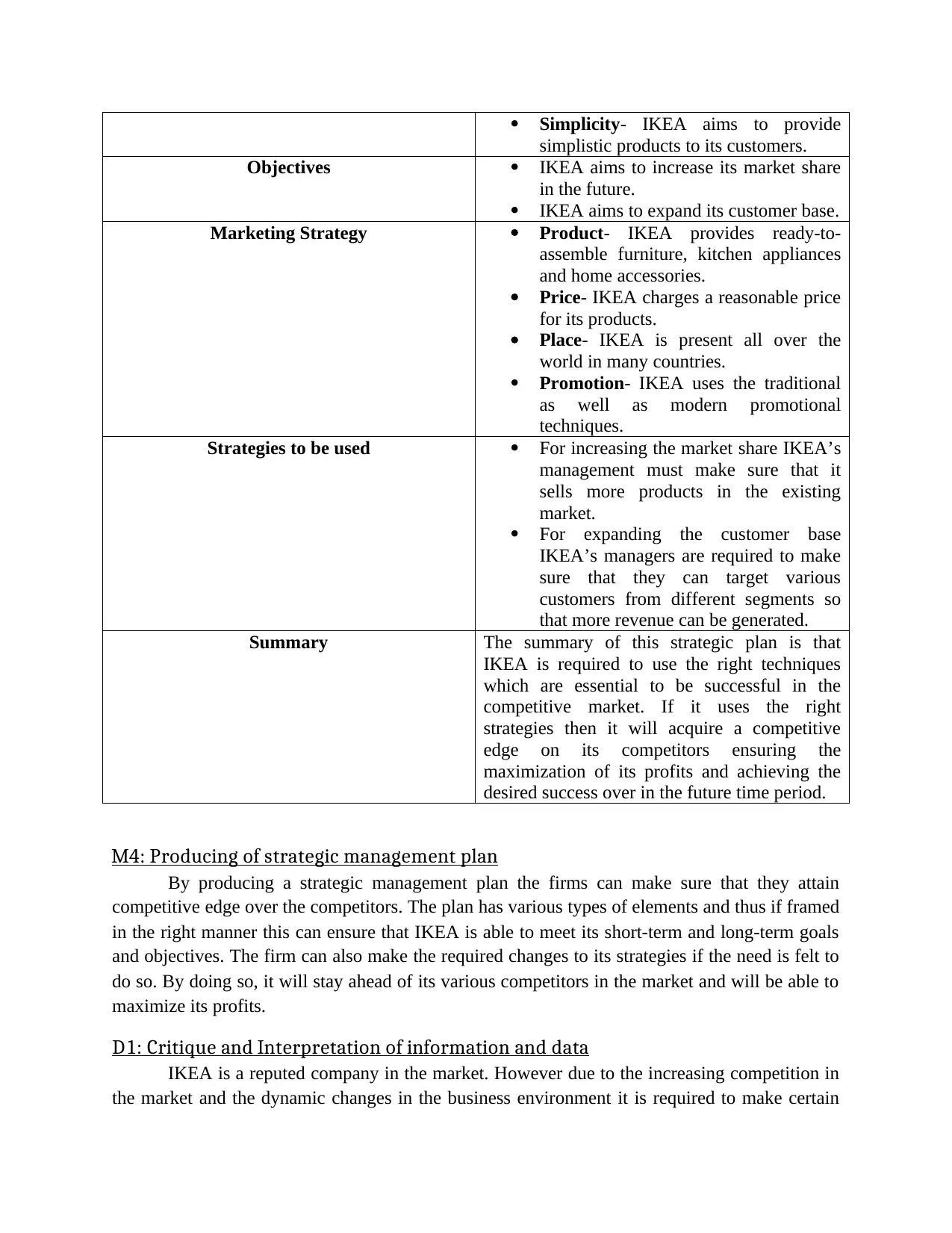
Simplicity- IKEA aims to provide
simplistic products to its customers.
Objectives IKEA aims to increase its market share
in the future.
IKEA aims to expand its customer base.
Marketing Strategy Product- IKEA provides ready-to-
assemble furniture, kitchen appliances
and home accessories.
Price- IKEA charges a reasonable price
for its products.
Place- IKEA is present all over the
world in many countries.
Promotion- IKEA uses the traditional
as well as modern promotional
techniques.
Strategies to be used For increasing the market share IKEA’s
management must make sure that it
sells more products in the existing
market.
For expanding the customer base
IKEA’s managers are required to make
sure that they can target various
customers from different segments so
that more revenue can be generated.
Summary The summary of this strategic plan is that
IKEA is required to use the right techniques
which are essential to be successful in the
competitive market. If it uses the right
strategies then it will acquire a competitive
edge on its competitors ensuring the
maximization of its profits and achieving the
desired success over in the future time period.
M4: Producing of strategic management plan
By producing a strategic management plan the firms can make sure that they attain
competitive edge over the competitors. The plan has various types of elements and thus if framed
in the right manner this can ensure that IKEA is able to meet its short-term and long-term goals
and objectives. The firm can also make the required changes to its strategies if the need is felt to
do so. By doing so, it will stay ahead of its various competitors in the market and will be able to
maximize its profits.
D1: Critique and Interpretation of information and data
IKEA is a reputed company in the market. However due to the increasing competition in
the market and the dynamic changes in the business environment it is required to make certain
simplistic products to its customers.
Objectives IKEA aims to increase its market share
in the future.
IKEA aims to expand its customer base.
Marketing Strategy Product- IKEA provides ready-to-
assemble furniture, kitchen appliances
and home accessories.
Price- IKEA charges a reasonable price
for its products.
Place- IKEA is present all over the
world in many countries.
Promotion- IKEA uses the traditional
as well as modern promotional
techniques.
Strategies to be used For increasing the market share IKEA’s
management must make sure that it
sells more products in the existing
market.
For expanding the customer base
IKEA’s managers are required to make
sure that they can target various
customers from different segments so
that more revenue can be generated.
Summary The summary of this strategic plan is that
IKEA is required to use the right techniques
which are essential to be successful in the
competitive market. If it uses the right
strategies then it will acquire a competitive
edge on its competitors ensuring the
maximization of its profits and achieving the
desired success over in the future time period.
M4: Producing of strategic management plan
By producing a strategic management plan the firms can make sure that they attain
competitive edge over the competitors. The plan has various types of elements and thus if framed
in the right manner this can ensure that IKEA is able to meet its short-term and long-term goals
and objectives. The firm can also make the required changes to its strategies if the need is felt to
do so. By doing so, it will stay ahead of its various competitors in the market and will be able to
maximize its profits.
D1: Critique and Interpretation of information and data
IKEA is a reputed company in the market. However due to the increasing competition in
the market and the dynamic changes in the business environment it is required to make certain
⊘ This is a preview!⊘
Do you want full access?
Subscribe today to unlock all pages.

Trusted by 1+ million students worldwide
1 out of 16
Related Documents
Your All-in-One AI-Powered Toolkit for Academic Success.
+13062052269
info@desklib.com
Available 24*7 on WhatsApp / Email
![[object Object]](/_next/static/media/star-bottom.7253800d.svg)
Unlock your academic potential
Copyright © 2020–2025 A2Z Services. All Rights Reserved. Developed and managed by ZUCOL.





